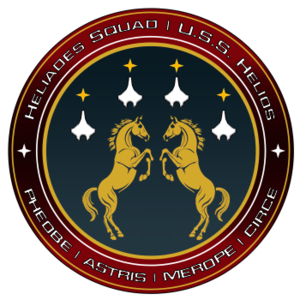USS Helios
More actions
- "The test of any man is in action."
- —Pindar
USS Helios (NCC-63284) is an Akira-class Federation starship assigned to Fourth Fleet's Task Force 47
Service History
Commissioning and Early Service
One of the first block of Akira class vessels produced in 2363, Helios was part of the wave of new designs rapidly sweeping across the fleet that explored a different form of shipbuilding that focused on mission specialisation over larger multi-role vessels. Spending much of the next two decades undertaking operations at the Cardassian Border, Helios also served with distinction during the Dominion War as part of the Fourth Fleet's space command programme, defending key locations throughout the war front.
Helios was present in the task force that supported the efforts of Stargazer and the Jurati Collective to defend against the dangers of the temporal and spatial anomaly. Following these events the ship underwent a major overhaul at the Avalon Fleet Yards to modify it for deployment with Task Force 47.
Threadbare Flags
In 2401, Helios found themselves redeployed to the Cardassian border following the destruction of Outpost C-91, reportedly by the True Way separatist movement. Initially assigned reconnaissance and overwatch responsibilities in the expansive region, utilising it's large number of auxiliary craft to supplement long-range sensor platforms, Helios was part of a network providing real time oversight of the region. When a personal message to a young Lieutenant suggests an imminent bomb threat from the New Maquis, Helios is retasked to Cyodan II, to investigate the security threat.

Late in the year 2401, Helios was assigned to act as a research support platform for a new long-range sensor suite designed to improve surveillance in the Badlands. While testing the new platform, the vessel was caught unaware by the opening of a subspace aperture related to the galaxy-wide Underspace emergence. Transported several thousand lightyears through the Underspace corridors, Helios was damaged and stranded in a remote system where the high level of electromagnetic and stellar radiation made attaining warp speeds impossible.
Whilst undertaking repair works in the system and investigating possible avenues for their return to Federation space, Helios encountered a remote Kazon colony, seemingly separated from the other members Kazon Collective over 50 years prior. These Kazon appeared to have settled on the planet and were operating a satisfactory subsistence lifestyle. When it became apparent that the access portal to the Underspace was collapsing due to the activities of the Cardassian Union in the Alpha quadrant, Helios was forced to take the risk and attempt to return to Underspace unprepared. The Kazon revealed they were not as peaceful as believed and launched an attack on Helios to secure its advanced technology, having been unable to open the portal themselves with their limited assets. A standoff followed as Helios faced a trio of Kazon vessels at the mouth of the collapsing Underspace portal.
Helios was able to return to the Alpha quadrant but incurred several losses, including Heliades flight leader Helena 'Pheobe' Tyll, who sacrificed herself to transmit vital data to the ship whilst captured aboard the Kazon lead vessel. The ship returned to Deep Space 47 for repairs and post-action debriefing before attending the Commander’s funeral on Trill.
Following reports of increased activity from the Orion Syndicate, Helios began pursuing intelligence regarding an increasing number of xBs going missing in the space around the syndicate controlled Pamack Base. The ship deployed an undercover team to the moon with the aims of investigating the intelligence and if possible, securing the safety of the missing xBs. The team deployed to the moon whilst Helios remained stationed at K-74 and met with their contact, Aspis. After some intial confusion and an unfortuante trading of weapons fire, the contact revealed herself to be an agent of the Klingon Empire who was also investigating the disappearence of xBs. After confirming her credentials via friendly connections in the Empire, the team proceeded to a black market auction where Aspis confirmed her target, a pirate with whom she had embedded herself, would be purchasing the captured colonists.
Whilst the first team observed the warehouse, a second team withdrew to the commandered transport to provide support and overwatch. Following fruitless observations, the ground team decided to enter the base to aquire more information. At the same time Helios was contacted by the Klingon Empire to advise them that their records had been incorrect, the agent in question had been disavowed as a renegade. With the away team out of contact, Helios made best speed to Pamack.
Unfortunately the ship was too late and on arrival they found the ground portion of the away team to have been captured by someone utilising Borg technology from the Unimatrix Zero refugee ship Exodus. A security force was dispatched to rescue the team and secure the warehouse where the transport team had last recorded their signatures. Upon their arrival they found the warehouse abandoned and one of the team missing, the other two unconcious and restrained.
Much to the dissapointment of the crew, it appeared that Commander Bib, the vessel's XO, had left with the pirate and the renegade intelligence officer. His intentions are currently unknown but internal reports suggest he has turned renegade.
Design and Capabilities
Heliades Squadron

Originally created to take advantage of the Helios' through-deck design as it fulfilled escort carrier duties during the Dominion War; Heliades Squadron has found new life as a specialist service unit. In a galaxy of instant transporters and increased automation, several members of Starfleet Operations have identified a critical vulnerability in starship operations when these systems are rendered unavailable. Whilst effective mass-produced vehicles, the standard shuttle designs are created with adaptability in mind and as a result cannot provide high level support to star ships and operations. The need for craft and officers who can provide expert logistical support & mobile services aboard larger ships, over and above the standard training of shuttle pilots was becoming evident. Heliades squad are experts with a wide range of auxiliary vehicles, their operation and usage, including shuttles, combat auxiliary craft (such as the Valkyrie-class starfighter) and ground craft, including traditional motorised and wheeled vehicles.
Notable Locations
The Orrery
Situated in the enclosed centre of Helios' flight deck, the Orrery is the command centre of the ships' flight wing and Heliades squadron. A modification of the auxiliary bridge, the Orrery takes advantage of the room's command and control systems as well as the direct connection to the ship's computer and sensor systems to manage the airspace around Helios. With a number of dedicated stations for the management of Helios' vast shuttle bays and a live link to the main bridge, the Orrery acts as a CIC during combat but most importantly provides vital operational & strategic support during humanitarian and transport missions.
With Helios' recent return to non-combat duties with Task Force 47 and the Fourth Fleet's return to a more scientific mission brief, the Orrery has received a permanent contingent of science officers into the duty roster. These scientists provide support to the divisions's exploratory efforts, utilising the ship's huge number of auxiliary craft to extend the reach of the ship's sensors and directing their efforts to survey systems with surprising speed.
Sunspot Lounges

The Akira-Class vessels make novel use of space to facilitate social areas for almost 500 crew members with limited space. Several large open plan messes combined with passing place style corridor lounges (taking advantage of lessons learnt with the Galaxy class) allow Helios to make use of normally wasted space. Nestled on the port and starboard trailing edge of Helios' deck 8, the twin sunspot lounges are one of the ship's more subdued and intimate social spaces, converted from small junior messes.
Fitted with a number of private booths and sofas, the low lighting and ambient music that spills forth from hidden speakers gives the lounges a more intimate feel for evenings of quiet gatherings and rendezvous. The twin lounges feature a number of privacy considerations such as inbuilt replicators in the booth's tables, holographic dividers and an all-holographic bar and waiting staff. The focal point of each booth is a large aft quarter-facing window giving unobstructed views out into space, which more than once has caused a subtle course correction to maximise a romantic vista.
